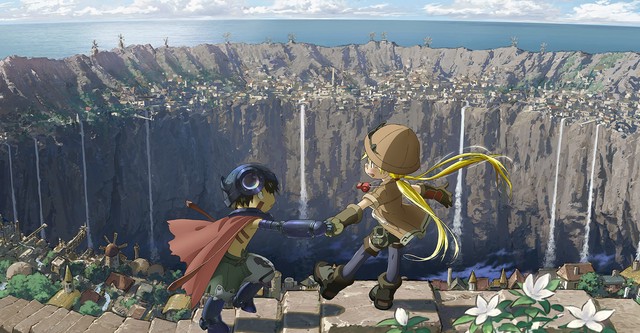A Look Back at Made in Abyss Season One

Tanner McEveety ‘22 / Emertainment Monthly Video Games Editor
It’s strange witnessing the release of Made In Abyss season two. The world has changed significantly since the first season aired, but simply hearing about the show again nonetheless calls to mind those old scenes, characters, and images, proving just how unforgettable they are. Such staying power undoubtedly warrants a look back.
Made in Abyss follows Riko, a young girl working as a cave diver for her orphanage, and Reg, an amnesiac robot boy who seems to have come from the very bottom of the titular Abyss—a massive hole in the ground crawling with bizarre wildlife and ancient secrets. Lured down by the mysteries of the Abyss’s nature, Reg’s origins, and Riko’s mother’s disappearance, the duo embark on a journey into the depths from which they do not expect to return.
Riko and Reg serve as the audience’s window into the setting, but the Abyss is so full of life and what feels like malignant sentience that it’s hard to not think of it as a third main character. For every stunning vista, there’s a horrifying creature whose jagged, sketchy lines break the established art style. Interesting concepts like upside down forests and shipwrecks found somewhere a ship could not possibly have ever sailed make every new discovery unique. Each separate “layer” of the Abyss has its own distinct flavor, and as Riko and Reg journey ever downwards, the story gets darker and more disturbing, selling the idea that the Abyss becomes more dangerous the further down a person ventures.
It’s the perfect setting to contrast wonder and horror, the same mixture of awe and fear that one experiences at the edge of a high place. There’s an undeniable grandeur to the wide, perfectly circular hole that the city of Orth is built around, and it’s entirely understandable that so many people would want to explore it. But it’s also hard not to view that gaping blackness as an open maw, ready to swallow up whoever dares enter. Most likely inspired by the real world phenomenon of decompression sickness, the Curse of the Abyss causes great bodily harm to anyone who dares ascend from the Abyss’s depths, symptoms worsening the further down they are. Like a finger trap, it’s easy to enter the Abyss, but significantly harder to leave.
Wonder and horror are also contrasted in the natural behaviors of predators and prey. Among the vicious, intelligent animals of the Abyss, Riko and Reg are not untouchable observers. They are simply a part of the food chain. The show highlights the beauty of symbiotic relationships and the cycles of nature, but it also does not shy away from the brutality of hunting and killing to survive. Riko and Reg happily gut, cook, and eat various adorable creatures so that they might survive. Meanwhile, predators hunt their prey in a variety of horrifying ways, and often turn these methods onto the duo.
There are many different ways that their journey into the depths can be read. It’s perhaps best described as a meditation on death, temptation, and the fundamentally unknowable nature of the world. However, looking only at season one, there is no concrete ending, no final note that colors the entire series with a certain theme, and no reveal for all the unanswered questions. There’s undoubtedly inherent meaning in that unfinished journey, but what resonates strongest are the show’s many standout moments. Goodbyes at windy cliff edges, existentially terrifying epiphanies, calm smiles beside cooking meals, soul-sucking terror in the face of gruesome deaths, heart-twisting confrontations of grief, meaninglessness, and loss. Even divorced from whatever ultimate message might arise from a completed story, these moments are emotionally affecting on a level little else can match.
Such moments are aided by Kevin Penkin’s incredible score, which no discussion of Made in Abyss is complete without mentioning. In each track, the viewer can hear the elements of the show coming to life. Riko and Reg’s innocence, in tinkling, upbeat tunes and relaxing acoustic guitar. The terror they face, in pounding drums. The emotion they feel, in touching piano and gently sung lyrics. But most of all, the Abyss itself, characterized with deep bass notes, airy, roaring drones, and mysterious melodies on violin and piano, drifting by on the breeze, luring the listener down, and down, and down. Penkin’s ability to evoke unknowability and scale is beautiful in its own right, but also an uncannily perfect match for the material.
The conversation hasn’t settled yet, so it’s unclear how Made In Abyss may eventually be looked at as a whole. But enough time has passed since season one to ensure its place in popular memory as a fascinating, infinitely compelling enigma. One that grabs and does not let go, not until it’s dragged the prey in its clutches deep, deep below…